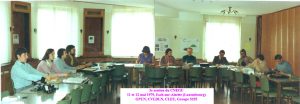For many years the Italian Center for UFO Studies (Centro Italiano Studi Ufologici, CISU) and a few foreign scholars have been systematically updating an international catalog (and collecting a copy, whenever possible) of all the university theses about UFOs and related subjects, within the “Science.Cat”, a project coordinated by Paolo Toselli since 1985 in order to collect a bibliography of scientific literature (articles, books and book chapters) of potential interest for the study of UFO phenomena.
The catalog, now in its fifth edition and updated to June 2019, includes 352 dissertations (from 1948 to 2018), almost all within social sciences, except for three ones in applied sciences (engineering and medicine), one in natural sciences (astrophysics) and four in architecture. 40% of the theses come from the USA, although there were none from this geographical area in the last three years.
Statistically, the most “prolific” year was 1998 (29 dissertations, 11 of which in the USA). Years 2001 (21 theses, 11 in the USA) and 2005 (21 again, but only 4 from the USA) are close on the heels.
As of academic degree levels, there are 67 theses for obtaining the “bachelor’s degree”, 142 theses for the “master’s degree”, and 117 dissertations for the “Ph.D.”.
Only a few students continued to research the UFO phenomenon after graduation. Among those, we can quote David Jacobs, Thomas Bullard and Mark Rodeghier from the USA, Peter Rojcewicz and Shirley McIver from Great Britain, Roberto Banchs from Argentina, Ulrich Magin from Germany, Pierre Lagrange from France, Jean-Michel Abrassart from Belgium, Ignacio Cabria and Ricardo Campo Pérez from Spain, Roberto Pinotti from Italy, Robert Bartholomew from New Zealand, Jaakko Närvä from Finland. Some of them were actually involved in ufology before their graduation.
In the last 20 years, the Italian Center for UFO Studies has provided several free general and bibliographic consultations to Italian university students working on UFO-related dissertations. UPIAR publishing Cooperative has even published some of those Italian theses as a book or monograph.
 The whole database prepared by Paolo Toselli is now available online to the general public, while it had only circulated on selected international blogs and mailing lists in past years.
The whole database prepared by Paolo Toselli is now available online to the general public, while it had only circulated on selected international blogs and mailing lists in past years.
That work is constantly updated and anyone can cooperate with new entries. The CISU is also available to provide advice to students and researchers wishing to write a dissertation on the UFO subject.
– – –
Top picture: yearly distribution of dissertations about UFOs.
In the lower photo: Paolo Toselli, CISU


















 Born in 1970, he’s a generalist engineer with a specialisation in electronics & signal processing (after Maths Sup and Maths Spe).
Born in 1970, he’s a generalist engineer with a specialisation in electronics & signal processing (after Maths Sup and Maths Spe).